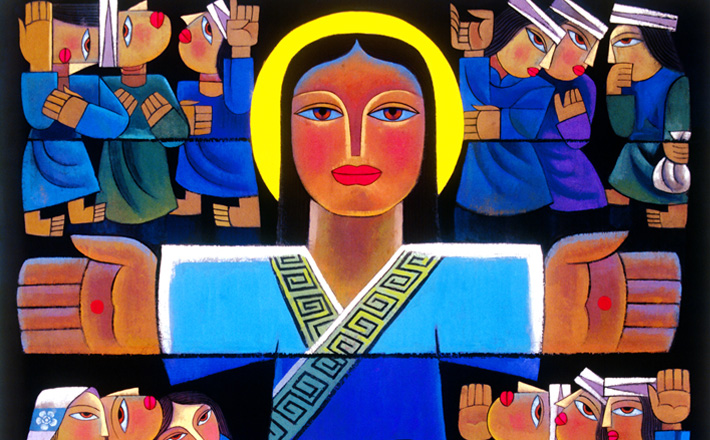Commentary on 1 Corinthians 15:19-26
At centuries’ distance from the Corinthian community, it is difficult to initially grasp why there would be disputes of basic faith questions such as described in chapter 15.
Yet, Paul is alert to what the areas of debate are among the Corinthians and thoroughly engages them. And indeed, Christians today still dispute their beliefs. What does that fact mean for Easter proclamation?
In order to get the flavor of what Paul is arguing about overall, the preacher should read chapter 15 in its entirety prior to any homiletical choices on this appointed epistle text for the day. This chapter is unique in the New Testament since no other section of the Bible so clearly works out with such depth the several related faith issues of a Christian community which is dealing with death, resurrection, and the way Jesus functions in these realities.
From Paul’s words, it is evident that the Corinthians are confused about the varied connections among death and dying, Jesus’ death, and the ways Jesus and his salvific work affect them and all of humanity. One thing this text does implicitly is look at the many fears believers have regarding life and death. Paul’s words seem to be addressed to those who are experiencing significant spiritual anxiety.
Studying the Text: Major Themes
This Epistle selection leaves no doubt that the way Jesus, as God’s beloved Son, works on behalf of humanity is part of God’s promise for the conclusion of all things that will signify the completion of God’s plan for humanity. This necessitates the unfolding of the salvation story through Jesus’ presence and actions, including the destruction of death, humanity’s major enemy.
This excerpt from chapter 15 is part of an extended Pauline challenge to the Corinthian community about their disputes over the nature of Christ and his relationship to their dying and salvation. The nature and object of Paul’s description of Christ’s place in humanity’s story moves through Jesus’ death to his assumption of power because of God’s work through him. In preaching this passage, the order in which Paul presents these issues should be followed to make sense of his line of reasoning.
For example, Paul’s description of the process of Jesus coming in glory with those who belong to him, and then the destruction of death and Christ’s reign with God, clearly sounds like an eschatological invitation to all listeners in every place and time to think about Jesus’ salvific work over the span of eternity. Focusing on the meanings of the person and works of Jesus Christ, with Christological depth, Paul addresses the Corinthians’ issues with resurrection, including their misunderstandings, fears and disputes. Paul chides them about several misunderstandings; including the central problem of those who had reservations about Jesus rising from the dead at all and what is at stake for them eternally in believing Jesus was resurrected.
The question that immediately comes to the fore with this text is: What is about it that recommends itself for proclamation on Easter Sunday? In some details, this Epistle selection indirectly raises topics similar to those implied in the Gospel for the day, but it does so in a more argumentative fashion, given the difference in the narrative structures of each text.
Resources on the Text
Even though the pericope for this day is contained within a thirty-eight verse chapter, of which main topic is the resurrection, the preacher should read about all of chapter 15 in a number of commentaries, given the text’s complexity. One commentary that can offer substantial sermonic insights is Martin Luther’s own commentary on 1 Corinthians 15.
Crafting the Sermon and Sermon Structures
There are many possible topics for preaching within this text. Sermonic structure can reiterate and reflect the major points Paul is making in the text. Some of the issues Paul addresses in this passage can be put in interrogatory form as a way of planning sermon structure. For example,
- What does it mean to be among the “first fruits of those who have died”?
- Why are Adam and Jesus paired in this text? What is the “last enemy” and why? (15:16)
- Will people be raised from the dead or once a person dies, do they remain dead?
- Was Jesus raised from the dead and why? If so, by whom?
Sermon preparation on this text must also take into consideration the reservoir of meanings attached to the Old Testament allusion to Adam in verse 22. A sermon section on the meaning of Adam in relationship to Jesus would further assist listeners in trying to make the Christological connections between the Old Testament figure of Adam and Jesus. Furthermore, discussing the relationship theologically and typologically would be good for naming the resurrection as the divine response to the fallibility of humanity, which is tied to the “old Adam.”
The Adam/Jesus pair can also be used to discuss the human condition since the mention of this comes naturally on Easter Sunday given the aegis of sin and the reality of the atonement, of which Easter is the central festival to proclaim these realities through the lenses afforded by the saving Cross.
The time difference between the Corinthians’ community and any contemporary Christian community has not necessarily alleviated the spiritual questions and fears people have about their salvation. These fears are met by the Easter resurrection reality, and preachers should never cease raising them. As with Paul’s case, theological and scriptural responses are always needed for good spiritual care as people grapple with God’s workings among them.
Humanity is haunted by death. The Corinthians’ issues about the processes of salvation raise questions for people today both spiritually and educationally. The Easter Sunday preacher should not underestimate questions and spiritual struggles experienced by many today. We all wonder “what role does Christ have in the death of each person?” and “how does Jesus’ death affect the event of my death?”
These are typical questions and Easter proclamation on some of these questions offers the heart of what the resurrection means for Christians in view of the hope Easter offers to humanity. In a sermon, it is this hope that people yearn to hear on Easter — and it is spelled “R-e-s-u-r-r-e-c-t-i-o-n!”


March 31, 2013